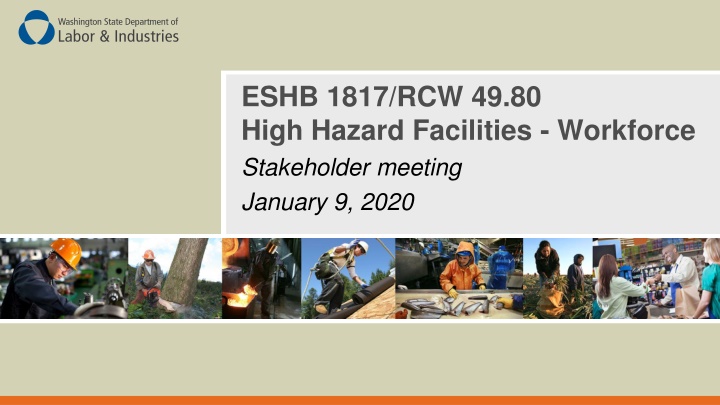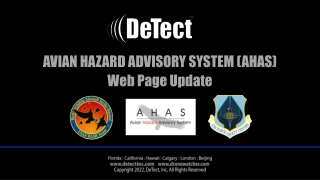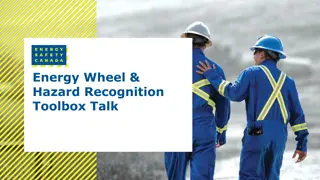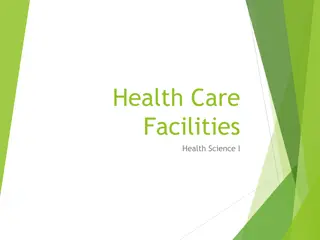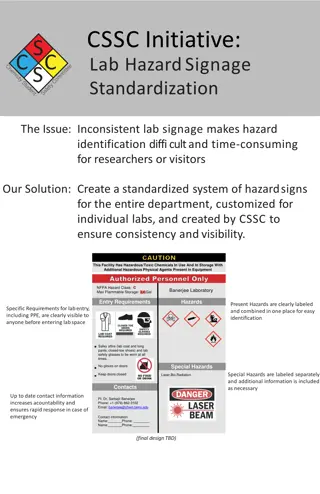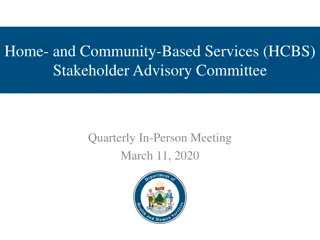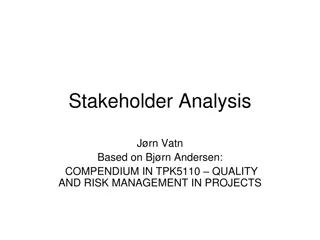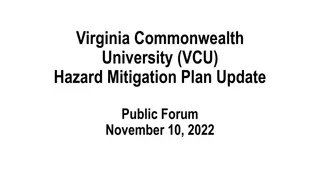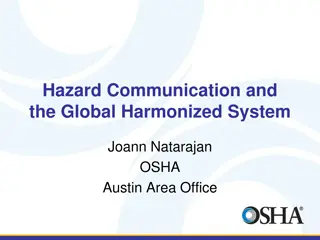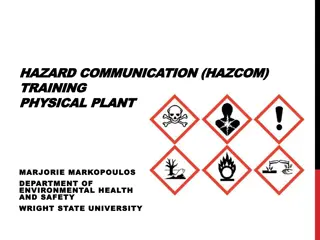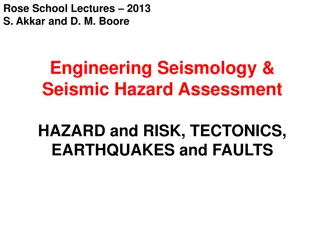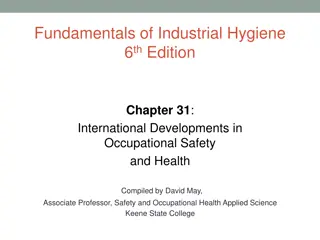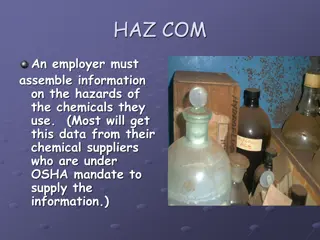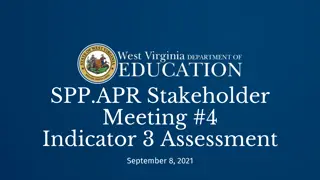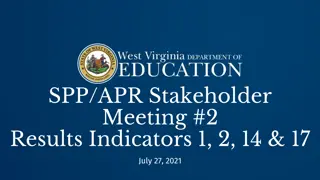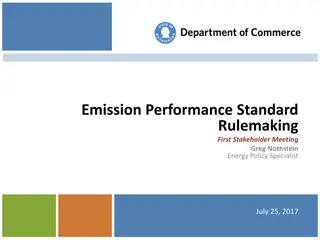ESHB 1817/RCW 49.80 High Hazard Facilities Stakeholder Meeting Overview
The stakeholder meeting discussed ESHB 1817 requirements for skilled and trained workforce in high hazard facilities, focusing on contractors in building and construction trades. It outlined exclusions, applicability, and exceptions to these workforce requirements. Key speakers included Maggie Leland, Jim Kaltenbaugh, and Alan Lundeen from DOSH and Labor & Industries. The meeting highlighted the importance of compliance and next steps in rulemaking.
Download Presentation

Please find below an Image/Link to download the presentation.
The content on the website is provided AS IS for your information and personal use only. It may not be sold, licensed, or shared on other websites without obtaining consent from the author.If you encounter any issues during the download, it is possible that the publisher has removed the file from their server.
You are allowed to download the files provided on this website for personal or commercial use, subject to the condition that they are used lawfully. All files are the property of their respective owners.
The content on the website is provided AS IS for your information and personal use only. It may not be sold, licensed, or shared on other websites without obtaining consent from the author.
E N D
Presentation Transcript
ESHB 1817/RCW 49.80 High Hazard Facilities - Workforce Stakeholder meeting January 9, 2020
Agenda Agenda Item Welcome and overview of ESHB 1817 Presenting Party Maggie Leland, Government Affairs and Policy Division Jim Kaltenbaugh, Apprentice Utilization Requirements Specialist Alan Lundeen, Senior Program Manager, DOSH Status and next steps - Apprenticeship Program Status and next steps DOSH Rulemaking Open to All Q&A 2 Washington State Department of Labor & Industries
Overview - ESHB 1817/RCW 49.80 Requires owners of petroleum refining or petrochemical manufacturing facilities use a skilled and trained workforce when contracting for construction, alteration, demolition, installation, repair, or maintenance work. 3 Washington State Department of Labor & Industries
What do the requirements apply to? Applies to: Contractors and subcontractors performing onsite work within an apprenticeable occupation in the building and construction trade 4 Washington State Department of Labor & Industries
What do the requirement not apply to? Onsite work exclusions Employees of the owner/operator of the refinery Where the contractor has asked for, but cannot get, qualified workers from local hiring halls or apprenticeship programs within 48 hours Emergencies that make compliance impracticable Where immediate action to prevent harm to public health or safety or to the environment is needed Requirement apply as soon as the emergency is over or it is practicable for contractors to obtain a qualified workforce 5 Washington State Department of Labor & Industries
Onsite work exclusions Ship and car support activities Environmental inspection and testing Security guard services Certain warranty work performed by an original equipment manufacturer Industrial cleaning and inspection services not related to construction Safety services requiring professional safety certification Non-construction catalyst loading, regeneration, and removal Chemical purging and cleaning Refinery byproduct separation and recovery Work performed that is not in an apprenticeable occupation 6 Washington State Department of Labor & Industries
Effective dates January 1, 2020 requirements in effect apply to work performed under contracts awarded, extended, or renewed on or after January 1, 2020 January 1, 2021 requirements in effect apply to work performed under contracts regardless of the date awarded Some requirements delayed or phased in 7 Washington State Department of Labor & Industries
What is a skilled and trained workforce? A skilled and trained workforce means a workforce that meets both of the following criteria: All the workers are either a registered apprentice in a Washington State Apprenticeship and Training Council (WSATC)-approved apprenticeship program or a skilled journeyperson The workforce meets the apprenticeship graduation requirements and approved advanced safety training requirements 8 Washington State Department of Labor & Industries
What is a skilled journeyperson? A skilled journeyperson is worker who meets all the following criteria: Has either graduated from a WSATC-approved apprenticeship program for the applicable occupation or has at least as many hours of on-the-job experience as would be required to graduate Is paid a rate commensurate with a rate typically paid for the occupation, and no less than the 75th percentile in the applicable occupation and geographic area in the most recent occupational employment statistics published by the Employment Security Department 9 Washington State Department of Labor & Industries
Apprenticeship Graduation Requirements Phased-in schedule for percentages of skilled journeyperson who must be graduates from a WSATC-approved apprenticeship program: by January 1, 2021, at least 20 percent by January 1, 2022, at least 35 percent by January 1, 2023, at least 45 percent by January 1, 2024, at least 60 percent 10 Washington State Department of Labor & Industries
Advanced Safety Training By January 1, 2022, all workers must have completed within the last three years at least 20 hours of approved advanced safety training L&I s Division of Occupational Safety and Health (DOSH) approves safety training curriculum in consultation with WSATC Training must be provided by a training provider approved by DOSH Approved trainer providers includes a registered apprentice program DOSH can accept training certificates from another state if it meets Washington State requirements 11 Washington State Department of Labor & Industries
Implementation Dates Implementation Date New Skilled and Trained Workforce Requirement Covered workers must be registered apprentices or skilled journey persons for work performed under contracts awarded, extended, or renewed on or after January 1, 2020 January 1, 2020 Covered workers must be registered apprentices or skilled journey persons for work on contracts regardless of the date awarded January 1, 2021 20% of skilled journeypersons must be graduates of a WSATC-approved apprenticeship program 35% of skilled journeypersons must be graduates of a WSATC-approved apprenticeship program. January 1, 2022 All covered workers must have completed the 20 hour safety training. 45% of skilled journeypersons must be graduates of a WSATC-approved apprenticeship program. January 1, 2023 60% of skilled journeypersons must be graduates of a WSATC-approved apprenticeship program. January 1, 2024 12 Washington State Department of Labor & Industries
L&I and WSATC - Roles Approval of new apprenticeship programs WSATC Administrative support of WSATC L&I Apprenticeship Program Enforcement of skilled and workforce requirements (expect wage payment requirements) L&I DOSH Approving Safety Training Curriculum L&I DOSH in consultation with WSATC Approving Safety Training Providers L&I DOSH Issuing training certificates L&I DOSH Investigation of wage payment requirements complaints L&I Employment Standards Program 13 Washington State Department of Labor & Industries
Status and Next Steps - Apprenticeship Program Working through the objection process on 8 sets of apprenticeship standard proposals Hearings will be conducted on 2 standards by the WSATC The other 6 have been sent to the Office of Administrative Hearing Working on scheduling mediation for each of these standards There are 6 new proposals for the January WSATC meeting as well as 2 federal programs requesting reciprocity All of these proposals have objections 14 Washington State Department of Labor & Industries
Status and Next Steps DOSH Rulemaking Skilled and Trained Workforce requirements included in upcoming proposed Refinery Process Safety Management rules DOSH Directive 24.70 currently in place Safety Training rulemaking 15 Washington State Department of Labor & Industries
Next Steps Safety Training We are looking at language in WAC 296-65, Asbestos removal and encapsulation for language and requirements This rule has sections on training course content, training course approval, issuing certificates and reciprocity with other states 16 Washington State Department of Labor & Industries
Next Steps - Safety Training The official rulemaking process will start in early February when the CR-101 is filed We intend to have the first rulemaking stakeholder meeting in mid to late March Copies of draft language will be made available to stakeholders ahead of the meeting 17 Washington State Department of Labor & Industries
Question? 18 Washington State Department of Labor & Industries
Contacts: Alan Lundeen, Senior Program Manager, DOSH alan.lundeen@Lni.wa.gov 360-902-4758 Jim Kaltenbaugh, Apprentice Utilization Requirements Specialist james.Kaltenbaugh@Lni.wa.gov 360-902-5373 Maggie Leland, L&I Policy Director Maggie.leland@Lni.wa.gov 360-902-4504 19 Washington State Department of Labor & Industries
